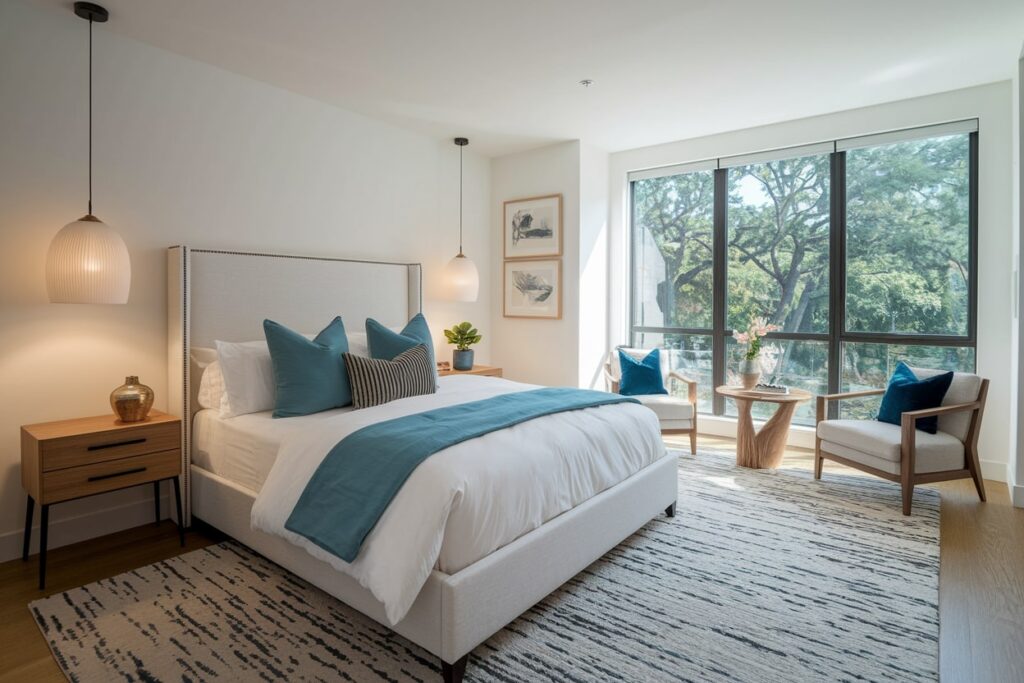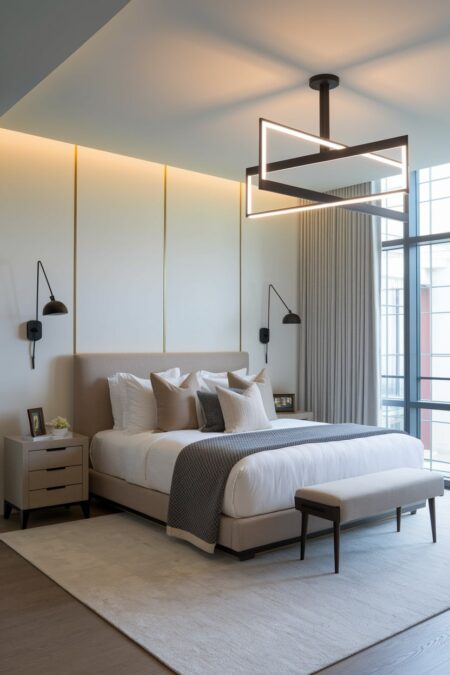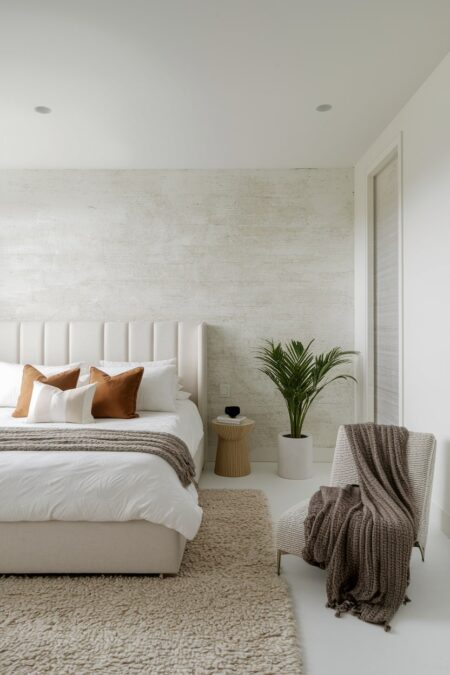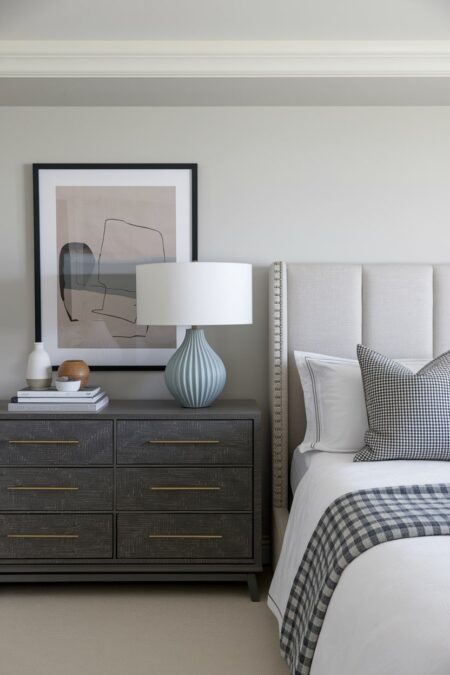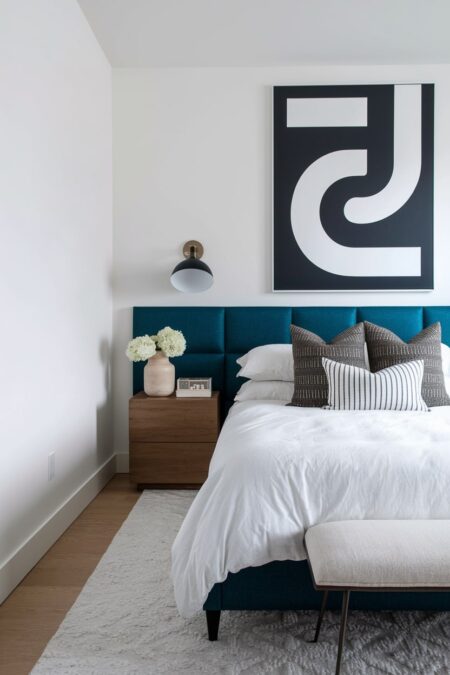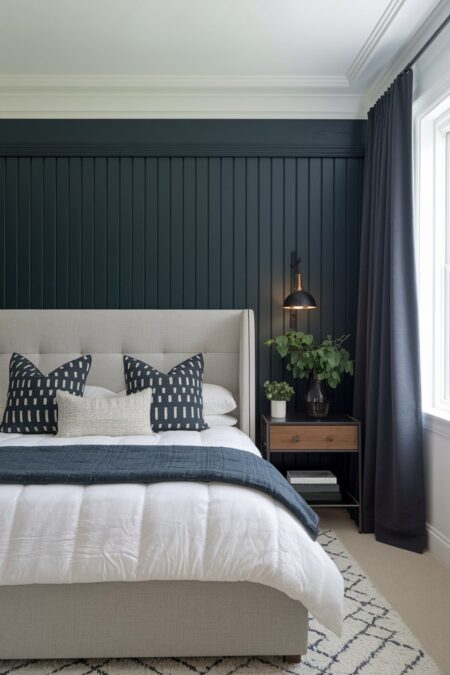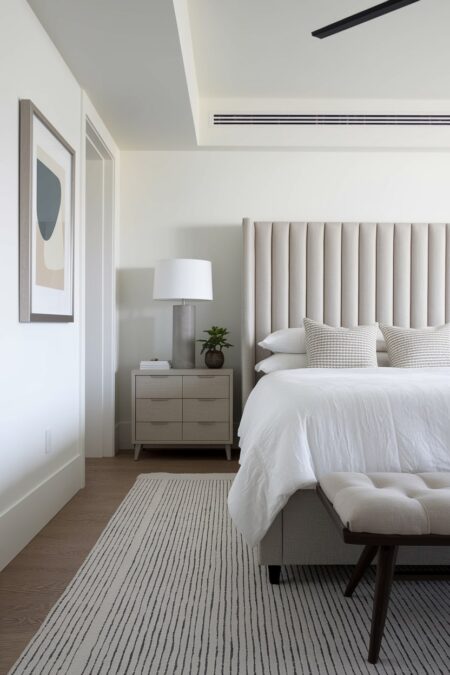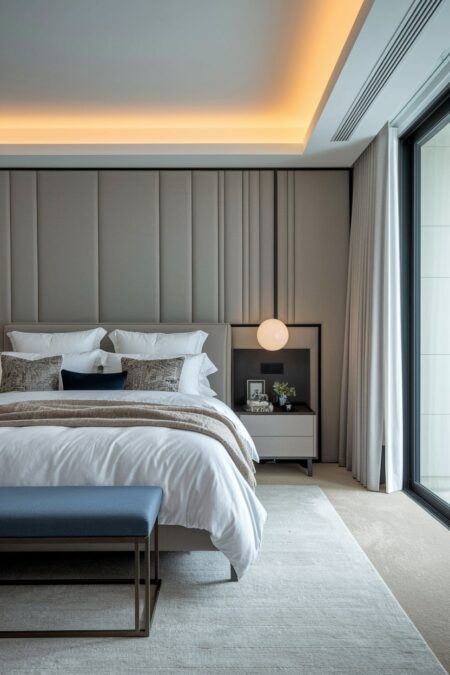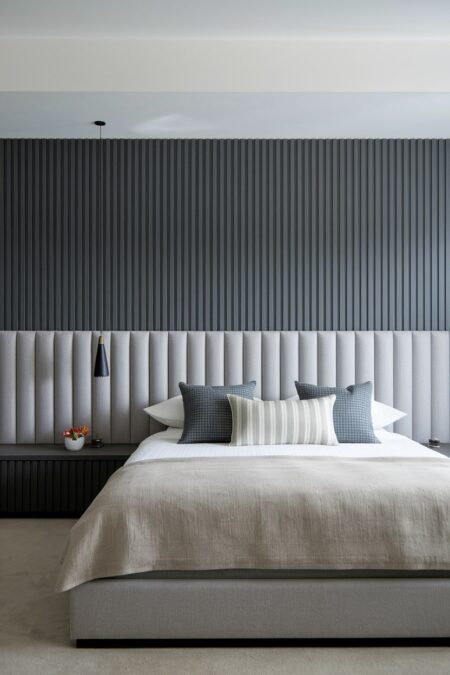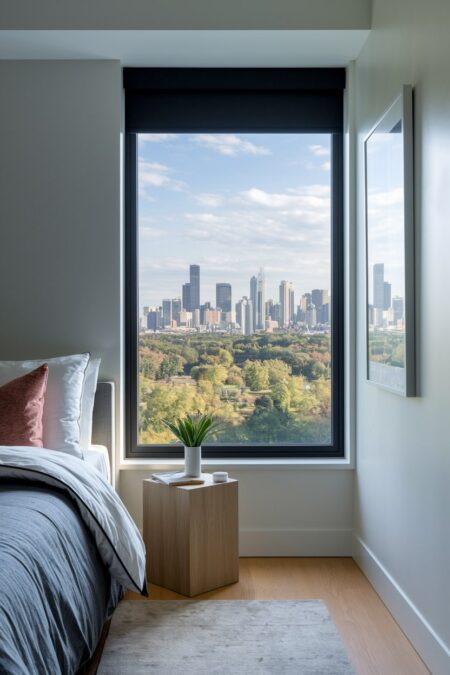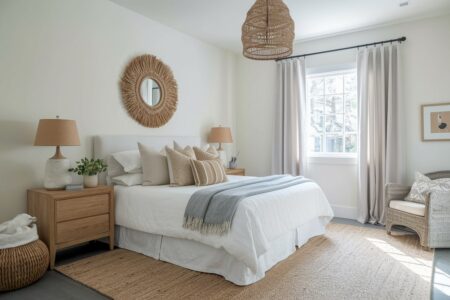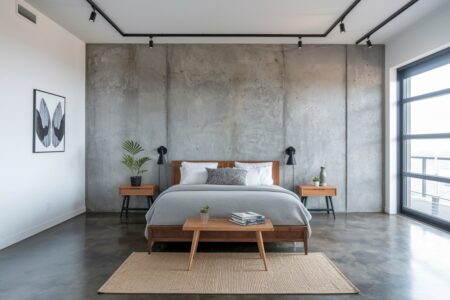The contemporary bedroom is more than just a place to sleep; it’s a personal sanctuary designed for rest, rejuvenation, and quiet reflection. Unlike modern design, which refers to a specific historical era (roughly the early to mid-20th century), contemporary style is dynamic, reflecting the trends of the here and now. It prioritizes clean lines, uncluttered spaces, and a sophisticated simplicity. The result is a space that feels both current and timeless, a tranquil retreat from the complexities of the outside world.
Creating this serene environment involves a thoughtful curation of furniture, color, texture, and light. It’s about balancing form and function to craft a room that is not only visually stunning but also deeply personal and comfortable. Below, we explore design ideas to help you transform your bedroom into a bastion of contemporary elegance.
-
01 of 18
Embrace the Low-Profile Platform Bed
The foundation of any contemporary bedroom is often a low-profile platform bed. Characterized by its lack of a box spring and its proximity to the floor, this style creates a grounded, serene focal point. Its clean, horizontal lines contribute to a sense of spaciousness, making the room appear larger and more open.
To bring this look into your space, select a frame made from natural materials like solid oak or walnut for warmth, or opt for an upholstered frame in a neutral fabric like linen or bouclé for a softer touch. Keep bedding minimalist with high-quality linens in solid colors or with subtle patterns, allowing the bed’s simple form to make a statement.
-
02 of 18
Cultivate a Neutral Color Palette
Contemporary design thrives on a sophisticated and calming color foundation. Think in shades of soft gray, warm beige, crisp white, and deep charcoal. These neutrals create a versatile backdrop that allows architectural details and curated decor pieces to stand out. A neutral palette fosters a sense of tranquility, which is essential for a restful bedroom environment.
A practical approach is to layer different tones of the same neutral family to add depth and prevent the space from feeling flat. For instance, pair light gray walls with a charcoal upholstered headboard (off-white shades will also work well) and dove gray bedding. This tonal variation adds visual interest while maintaining an overall cohesive and peaceful atmosphere.
-
03 of 18
Introduce Statement Lighting
Lighting in a contemporary bedroom is a functional necessity and a sculptural opportunity. Move beyond the standard ceiling fixture and consider a piece that doubles as a work of art. A large, architectural pendant light suspended over the bed or a minimalist chandelier with geometric lines can serve as the room’s primary focal point.
For a layered lighting scheme, supplement your statement piece with other sources. Wall-mounted sconces with articulated arms can provide focused reading light while freeing up space on your nightstands. Integrated LED strip lighting concealed within a custom headboard or beneath a floating bed frame can cast a soft, ambient glow that enhances the room’s modern feel.
-
04 of 18
Layer a Rich Variety of Textures
To prevent a neutral, minimalist space from feeling cold or sterile, the strategic use of texture is paramount. Introducing a variety of tactile surfaces adds warmth, depth, and character. Think about how different materials feel to the touch and how they interact with light.
Incorporate these elements through a plush, high-pile area rug under the bed, a chunky knit throw blanket draped across a chair, and velvet or linen accent pillows. You can also introduce texture on the walls with grasscloth wallpaper or a limewash paint finish, creating a subtle yet impactful backdrop.
-
05 of 18
Utilize Floating Furniture
A key tenet of contemporary design is the creation of an airy, uncluttered feel. Floating furniture, such as wall-mounted nightstands or vanities, is an excellent way to achieve this. By lifting pieces off the floor, you create uninterrupted visual lines that make the room feel more spacious and easier to clean.
When selecting floating furniture, choose designs with simple forms and minimal hardware. The “less is more” approach ensures the focus remains on the clean silhouette and the illusion of weightlessness. This design choice is particularly effective in small bedrooms for maximizing the perception of space.
-
06 of 18
Adopt a Minimalist, Curated Approach
Contemporary style is rooted in the principle of intentionality. This means every object in the room should have a purpose or bring personal joy. A minimalist approach requires you to declutter ruthlessly, removing anything that doesn’t contribute to the room’s serene and functional design.
Instead of displaying numerous small trinkets, select a few high-impact decorative pieces. A single, elegant vase on a dresser or a curated stack of art books on a nightstand carries more design weight than a collection of disparate items. This curated approach ensures the room feels calm and organized.
-
07 of 18
Hang Large-Scale Artwork
Art is essential for infusing personality into a contemporary bedroom. Rather than a gallery wall of smaller frames, opt for a single piece of large-scale artwork. An oversized abstract painting, a dramatic black-and-white photograph, or a large textile wall hanging can create a powerful and sophisticated focal point.
Position the artwork above the headboard or on the largest blank wall in the room. The key is to choose a piece that complements the room’s color palette and overall mood without overwhelming the space. The scale of the art should be proportional to the wall, making a confident and deliberate statement.
-
08 of 18
Integrate Biophilic Design Elements
Connecting with nature is a core component of contemporary living. Biophilic design, which involves incorporating natural elements into the built environment, can significantly enhance a bedroom’s sense of tranquility. The simplest way to do this is by adding indoor plants.
Choose plants with interesting leaf shapes and sculptural qualities, such as a Fiddle Leaf Fig, a Snake Plant, or a Monstera. Place them in minimalist ceramic or concrete planters. The greenery not only purifies the air but also adds a touch of organic color and vitality to the otherwise neutral space.
-
09 of 18
Conceal Clutter with Integrated Storage
A serene bedroom is an organized one. Contemporary interior design favors sleek, integrated storage solutions that blend seamlessly into the architecture of the room. Think custom-built, floor-to-ceiling wardrobes with flat-panel doors and no visible hardware.
For an even more streamlined look, consider a storage wall that conceals closets, drawers, and even a small desk area behind uniform doors. This approach creates a clean, monolithic surface that minimizes visual noise and keeps clutter completely out of sight, contributing to a calm and orderly environment.
-
10 of 18
Experiment with a Monochromatic Scheme
A monochromatic color scheme, which uses various tints, tones, and shades of a single color, is a hallmark of sophisticated contemporary design. This approach creates a harmonious and unified look that is both dramatic and soothing. Shades of gray, blue, or even greige work exceptionally well for this.
To successfully execute a monochromatic look, you must rely heavily on texture to create contrast and interest. Combine a matte wall finish with glossy furniture, silk drapes, and a wool rug — all in varying shades of your chosen color. This interplay of surfaces prevents the design from feeling one-dimensional.
-
11 of 18
Create Drama with a Bold Accent Wall
While neutral palettes are common, contemporary design is not afraid of a bold statement. An accent wall behind the bed is an effective way to inject color and personality without overwhelming the room. Choose a deep, moody color like navy, emerald green, or charcoal for a dramatic and intimate effect.
For a more textural approach, consider an accent wall clad in natural wood slats, upholstered panels, or geometric molding painted in the same color as the wall. This adds architectural interest and depth, elevating the design beyond a simple coat of paint.
-
12 of 18
Warm the Space with Natural Wood Tones
Natural wood brings an essential element of warmth and organic beauty to a contemporary bedroom. Incorporate wood through key furniture pieces like the bed frame, dresser, or a simple bench at the foot of the bed. Lighter woods like white oak or ash contribute to an airy, Scandinavian-inspired feel, while darker woods like walnut offer a richer, more grounded aesthetic.
To ensure the look remains contemporary, choose wood furniture with clean lines, simple forms, and a natural, matte finish. You can also introduce wood through architectural elements, such as a slatted wood feature wall or flooring, to create a cohesive and inviting atmosphere.
-
13 of 18
Mix Metals for a Modern Edge
Gone are the days of matching every metallic finish in a room. Contemporary design embraces the artful mixing of metals to create a layered and dynamic look. Combine warm metals like brass or copper with cool metals like matte black, chrome, or nickel.
The key to a successful mix is to establish a dominant metal and use one or two others as smaller accents. For example, you might choose matte black for your light fixtures and window hardware, then introduce brass through drawer pulls and the frame of a mirror. This curated approach feels intentional and chic.
-
14 of 18
Incorporate Subtle Geometric Patterns
While ornate patterns are generally avoided, clean geometric shapes and lines are integral to the contemporary aesthetic. Introduce these through an area rug with a subtle linear pattern, throw pillows with a simple geometric print, or a headboard with channel tufting.
These patterns should serve as a quiet point of interest rather than a loud, dominant feature. They add a sense of structure and rhythm to the space, reinforcing the design’s emphasis on clean lines and form without creating visual clutter.
-
15 of 18
Embrace Smart Home Technology
A truly contemporary bedroom leverages technology to enhance comfort and convenience. Integrate smart home features that can be controlled with your voice or a smartphone. This includes automated blackout blinds that can be programmed to open with the sunrise, smart lighting that can be dimmed to the perfect level for relaxation, and integrated speakers for ambient sound.
The goal is for the technology to be seamlessly integrated and almost invisible. This functional enhancement supports a modern lifestyle and contributes to the room’s overall sense of effortless sophistication.
-
16 of 18
Keep Window Treatments Simple and Unadorned
Heavy, ornate drapery has no place in a contemporary bedroom. Window treatments should be simple, functional, and clean-lined. Floor-to-ceiling sheer curtains in a neutral color can diffuse natural light beautifully while maintaining privacy. For complete light control, layer sheers with a discreet blackout roller shade.
For an even more minimalist look, consider simple panel curtains or unadorned Roman shades made from natural fabrics like linen or a cotton blend. The focus should be on maximizing natural light and maintaining a connection to the outdoors.
-
17 of 18
Design an Architectural Headboard
The headboard offers a prime opportunity to create a stunning architectural feature. Move beyond a standard rectangular frame and consider a custom, wall-to-wall design. This can be achieved with vertical upholstered panels, a series of wood slats, or a low-slung ledge that extends behind the nightstands.
This type of integrated headboard not only acts as a striking focal point but also makes the room feel more cohesive and custom-designed. It anchors the bed and provides a strong horizontal line that enhances the room’s contemporary geometry.
-
18 of 18
Frame a Beautiful View
If you are fortunate enough to have a window with a beautiful view of a city skyline, a garden, or a natural landscape, make it the centerpiece of the room. Arrange your furniture to maximize this connection to the outdoors. A minimalist window frame, painted in a dark color like charcoal or black, can act like a picture frame, drawing the eye outward and making the view even more dramatic.
In this scenario, all other design elements in the room should be kept understated to support, rather than compete with, the natural artwork just outside your window. This approach creates a space that feels expansive, peaceful, and deeply connected to its surroundings.
